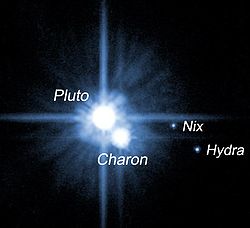- Nix (moon)
-
Nix  Discovery images of Nix (and Hydra)Discovery
Discovery images of Nix (and Hydra)DiscoveryDiscovered by Hubble Space Telescope
Pluto Companion Search TeamDiscovery date June 2005 DesignationsPronunciation /ˈnɪks/[a] Alternate name(s) (134340) Pluto II[1] Adjective Nictian Semi-major axis 48 708 km Eccentricity 0.0030 Orbital period 24.856 ± 0.001 d Inclination 0.195° Satellite of Pluto Physical characteristicsMean radius 23 − 68 km[3] Mass 5×1016–2×1018 kg[4] Mean density (unknown) Rotation period (unknown) Axial tilt (unknown) Albedo 0.04 − 0.35 (assumed)[5] Temperature 33–55 K Apparent magnitude 23.38 to 23.7 (measured)[5] Nix is a natural satellite of Pluto. It was discovered along with Hydra in June 2005, and is to be visited along with Pluto by the New Horizons mission in July 2015.
Contents
Discovery
Nix was found by the Hubble Space Telescope Pluto Companion Search Team, composed of Hal A. Weaver, S. Alan Stern, Max J. Mutchler, Andrew J. Steffl, Marc W. Buie, William J. Merline, John R. Spencer, Eliot F. Young, and Leslie A. Young. The discovery images were taken on May 15, 2005, and May 18, 2005; the moons were independently discovered by Max J. Mutchler on June 15, 2005, and Andrew J. Steffl on August 15, 2005. The discoveries were announced on October 31, 2005, after confirmation by precoveries from 2002. The moons were provisionally designated S/2005 P 1 (Hydra) and S/2005 P 2 (Nix).[6][7]
Orbit
The moon follows a circular orbit in the same plane as Charon. Its orbital period of 24.9 days is close to a 1:4 orbital resonance with Charon, but the timing discrepancy is 2.7%, which suggests that there is no active resonance.[2] A hypothesis explaining such a near-resonance is that it originated before the outward migration of Charon following the formation of all three known moons, and is maintained by the periodic local fluctuation of 9% in the Pluto–Charon gravitational field strength.
Physical characteristics
Although its size has not been directly measured, the moon has been calculated to have a diameter of between 46 km, if its geometric albedo is similar to Charon's 35%, and 137 km, if it has a reflectivity of 4%, like the darkest Kuiper Belt Objects.[3] Nix is slightly fainter than Hydra, suggesting that it is somewhat smaller in size.[5] In the discovery image, Nix is 6,300 times fainter than Pluto.[8]
Early research appeared to show that Nix was reddish like Pluto and unlike the other moons,[2] but more recent reports have been that it is grey like the remaining satellites.[5]
Name
The formal name "Nix", from the Greek goddess of darkness and night, and mother of Charon, was announced on June 21, 2006, on IAU Circular 8723,[7] where the designation Pluto II is also given. Together with Hydra, Pluto's third moon, the initials are those of the New Horizons probe. The initial proposal was to use the classical spelling Nyx, but to avoid confusion with the asteroid 3908 Nyx, the spelling was changed to Nix. The USGS Gazetteer of Planetary Nomenclature states that Nix is the "Egyptian spelling,"[9] while Jürgen Blunck explains it as the "Spanish translation" of the Greek name.[10]
Notes
- ^ In US dictionary transcription, US dict: nĭks′, or as in Greek Νύξ.
References
- ^ Jennifer Blue (2009-11-09). "Gazetteer of Planetary Nomenclature". IAU Working Group for Planetary System Nomenclature (WGPSN). http://planetarynames.wr.usgs.gov/append7.html#DwarfPlanets. Retrieved 2010-08-30.
- ^ a b c Buie, Marc W.; Grundy, William M.; Young, Eliot F.; Young, Leslie A.; Stern, S. Alan (2006). "Orbits and Photometry of Pluto's Satellites: Charon, S/2005 P1, and S/2005 P2". The Astronomical Journal 132 (1): 290. arXiv:astro-ph/0512491. Bibcode 2006AJ....132..290B. doi:10.1086/504422. http://iopscience.iop.org/1538-3881/132/1/290/fulltext. . a, i, e per JPL (site updated 2008 Aug 25)
- ^ a b H. A. Weaver; S. A. Stern, M. J. Mutchler, A. J. Steffl, M. W. Buie, W. J. Merline, J. R. Spencer, E. F. Young and L. A. Young (23 February 2006). "Discovery of two new satellites of Pluto". Nature 439 (7079): 943–945. arXiv:astro-ph/0601018. Bibcode 2006Natur.439..943W. doi:10.1038/nature04547. PMID 16495991.
- ^ Based on the range of diameters from Buie et al. (2006), and densities ranging from 1 g/cm3 (ice) to 2 g/cm3 (Pluto).
- ^ a b c d Stern, S. A.; Mutchler, M. J.; Weaver, H. A.; and Steffl, A. J. (2006). "The Positions, Colors, and Photometric Variability of Pluto's Small Satellites from HST Observations 2005–2006". Astronomical Journal 132 (3): submitted. arXiv:astro-ph/0607507. Bibcode 2006AJ....132.1405S. doi:10.1086/506347. (Final preprint)
- ^ IAU Circular No. 8625 describing the discovery
- ^ a b IAU Circular No. 8723 naming the moons
- ^ Brightness Difference on 2005-05-15: (5th root of 100) ^ (Nix APmag 23.38 – Pluto APmag 13.87) = 6,368x
- ^ "Planet and Satellite Names and Discoverers". Gazetteer of Planetary Nomenclature. USGS Astrogeology. July 21, 2006. http://planetarynames.wr.usgs.gov/append7.html. Retrieved 2006-08-15.
- ^ Blunck, Jürgen, Solar System Moons: Discovery and Mythology (2009), p. 129.
- Steffl, A. J.; Mutchler, M. J.; Weaver, H. A.; Stern, S. A.; Durda, D. D.; Terrell, D.; Merline, W. J.; Young, L. A.; Young, E. F.; Buie, M. W.; and Spencer, J. R. (2006). "New Constraints on Additional Satellites of the Pluto System". The Astronomical Journal 132 (2): 614–619. arXiv:astro-ph/0511837. Bibcode 2006AJ....132..614S. doi:10.1086/505424.(Final preprint)
External links
- Nix Profile by NASA's Solar System Exploration
- Background Information Regarding Our Two Newly Discovered Satellites of Pluto – The discoverers' website
- NASA's Hubble Reveals Possible New Moons Around Pluto – Hubble press release
- Two More Moons Discovered Orbiting Pluto (SPACE.com)
- Pluto's Newest Moons Named Hydra and Nix (SPACE.com)
Pluto Characteristics 
Discovery Exploration 20th-century classification 21st-century classification Other topics Moons of dwarf planets Trans-Neptunian objects TNO classes Plutoids & moons Categories:- Pluto's moons
Wikimedia Foundation. 2010.

